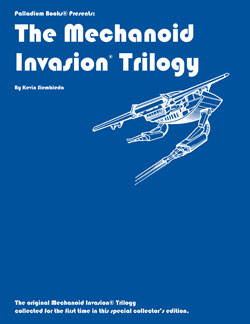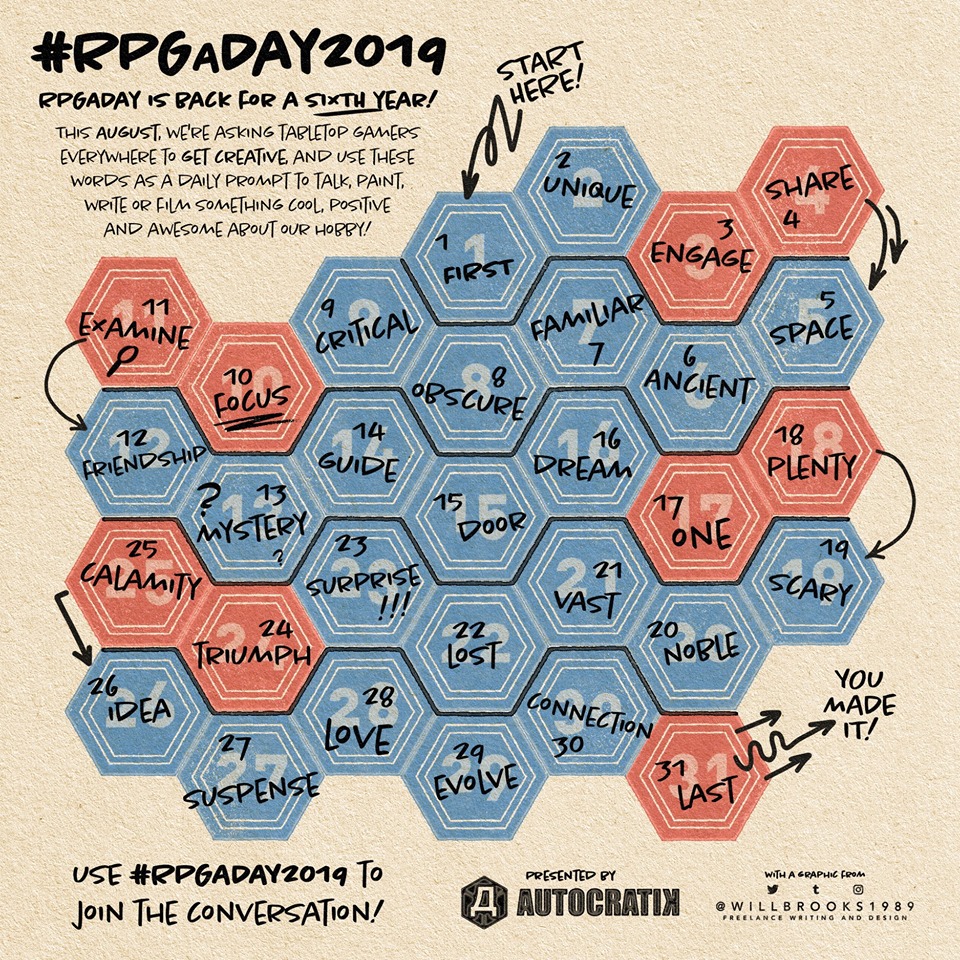Way back in the day when RPG.net was still worth reading there was a series of threads, “101 Day of” where someone tried to concentrate on one game. Today is the first day of one of those threads, ”101 Days of Palladium Books”, here on the blog. Today is also the first day of the RPG-a-Day challenge. I didn’t intend to have the start coincide with the first days of RPG-a-Day. It’s a happy accident. Those are firsts one and two.
The rules of the two events are straightforward. For the next 101 days I will focus my rpg time, outside of the Type IV D&D game I run every other week, on Palladium books games. For the month of August I will post about RPGs using the subject of the day from the chart above. If a particular day is uninspiring, I can roll a d6 and scatter.
That’s two out of three done.

The final, and biggest, first is the first Palladium RPG, The Mechanoid Invasion. It is a very cheap comic book sized book printed on newsprint. Kevin Siembieda, the author and one founder of Palladium Books, had a good deal of experience printing indie comics in the later 70s. When he couldn’t fund the big perfect bound RPG he wanted to produce, he saved and borrowed enough money to publish The Mechanoid Invasion in 1981. Two sequels, The Journey and Homeworld would round out what Palladium now calls The Mechanoids Trilogy. The return on the first book was enough to find a much larger third book on higher quality paper. In 1983 he would publish that big perfect bound RPG, The Palladium Roleplaying Game. It remains a major part of Palladium’s game line in a second edition and renamed The Palladium Fantasy Roleplaying Game.
The Mechanoid Invasion is set on Gideon E, a moon of a gas giant in a distant star system. From the book itself I am not sure if Gideon E is Earth’s only space colony or not. I can read it either way. The eponymous Mechanoids, who the colonists initially thought were a race of robots, have attacked the colony.
In reality the Mechanoids are engineered life forms. They are also insane with a hatred of humanoid life. Imagine Daleks who eschewed racial purity, allowing for gene-engineering for specific task and complex cybernetics.
We join the story in media res. The Mechanoids started by defoliating the planet then put down bases. Before the invasion, the colony watched as the Mechanoids broke down the other moons of Gideon into chunks. The Mechanoid’s mothership consumed these chunks as raw materials. They have destroyed several cities on Gideon E. The native humanoid life, the Rovers, are on the verge of starvation.
The rules are class and level based. While primitive they show all the hallmarks that would define the Palladium system from its beginning to the most recent game line, Dead Reign. Here the D&D roots are even more obvious, both in terms of rules and style. Instead of the base percentage plus a fixed amount per level for skills common in Palladium games these days there are full charts reminiscent of the thief skill charts in pre-third edition D&D.
Universal psionics, determined in a way not dissimilar to Appendix A of D&D Supplement 3: Eldritch Witchery or the AD&D Player’s Handbook, provide some special effects to character classes who are various military types with three exceptions. Land and air pilots, commandos, communication engineers, and light and heavy battle armor troops are the occupational character classes. The three odd balls are the Esper, who is a character with lots of psionics, and the two optional classes, a native Rover thief and the human thief.
Combat is the same system as classic D&D. As well as making you harder to hit, armor has damage points which need to be exhausted before characters lose hit points. This is cumulative damage over several turns instead of a fixed amount per hit. A character who is hit can give up his next attack to dodge the hit by rolling a higher score with his dodge bonus on a d20. An interesting omission is the armor rating for unarmored. The minimum 4 to hit in The Palladium would solve this Roleplaying Game. While the opposed role is present, structural damage capacity (SDC) is not used for characters, only objects. Characters only have hit points.
The Mechanoids have SDC using the same scale as human as do all the human vehicles. Mega-Damage Capacity (MDC) is still five years away along with the first iteration of the Robotech license.
The book is full of art. While I went through a long period saying the art in an rpg is irrelevant, back in the day I looked at The Mechanoids Trilogy because of reviews The Space Gamer issues 59 and 60 of The Journey and Homeworld respectively. I bought them in part because of the art. Kevin Siembieda illustrated the books with a few exceptions. I loved their strong comics style. The illustrations have a lot of labeling reminiscent of comics of the late 70s and early 80s and. If you remember the page at the back of their comic detailing the X-Men’s mansion or the Legion of Superheroes headquarters, you’ll get the same thrill with the diagrams of armor, weapons, vehicles, and Mechanoids.
Looking back, you can see how much of Palladium books was in place from the beginning. The strong presence of art to set the tone and get the reader invested in the game that is a Palladium hallmark is in this very first book. The rules system, although not yet having the fixed low to hit number at which point armor damaged occurs is not yet present, but the dodge is. Palladium remains one of the few roll to hit then roll to defend systems out there. The profusion of occupational character classes for what would appear to be same differences, here in the form of light versus heavy battle armor troops, is present. While PPE is not present, the ISP system of psionics appears.
More than anything, the goulash of ideas presented with uninhibited enthusiasm that channels Stan Lee as much as Gary Gygax is here. I did not know it at the time, but Kevin had considered trying to break into comics books. I don’t have a complete story of why he didn’t, but looking back at this product as a game written by someone who a year earlier had wanted to be at Marvel or DC make sense of many choices.
It also helps me understand the less positive things people say about Palladium products that were also already present in The Mechanoid Invasion. The hyperbole and the need to report extreme values is all over the lace. The Mechanoids’ mothership is “the size of North America.” While not unscientific in modern theories of interstellar travel, the phrase is pure comics. The arrangement of material is more stream of conciousness than a logical organization. At only 48 pages, the short length of The Mechanoid Invasion moderates this problem relative to later Palladium products. The sketchy nature of the rules is present. In 48 comic book sized pages it is hard to have detailed rules and all the setting material. That said, for 1981 the rules, while spare, were still within the range of expectations. Like the original D&D they assume some knowledge of the larger hobby, although RPGs instead of wargames.
So, The Mechanoid Invasion set the pattern for Palladium Books as a company way back in 1981. There is nothing in terms of structure or style in any of the books I will engage for the next 101 days not at least foreshadowed here.
The question is, would I play The Mechanoid Invasion today? Yes, yes I would. It would not be a long-term regular campaign using just the material in the first book or two, but it would work well for a few months of weekly play. I think for that kind of limited campaign I would use it as is. While it uses the Palladium system and would be easy to update to the second edition standards, I would not do that unless I intended to cross over.
Kevin has long promises a new game, Mechanoids Space, which I think would be somewhere between an expansion and sequel to Homeworld. There was a follow-up game in Palladium’s perfect bound format from the mid–80s set between the first and second books of the original trilogy. Kevin was not very satisfied with it and it has become one of the rare Palladium games to go out of print, although a PDF is on Drive-Thru-Rpg. The full original trilogy is also available in PDF. Even if you don’t play Palladium, I think they are worth it as source material for a gonzo OSR campaign or even a normal space or supers one.
Even without Mechanoids Space, Palladium has brought us the Mechanoids again. Rifts Sourcebook Two: The Mechanoids presents MDC versions of them ready for Rifts proper or as Phase World antagonists. Palladium collected and reprinted the original trilogy with some designer and conversion notes including MDC conversions. There is enough material to construct your own unique game using Phase World or Aliens Unlimited.
Tomorrow is the second day of the two challenges, the second of which has the keyword unique. With it we’ll look at some unique features of Palladium products.
RPG-a-Day 2019 Posts
Day 1: Three Firsts
Day 2: Unique Features of Palladium
Day 3: Engaging the World
Day 4: Sharing Jekyll and Hyde
Day 14: Dream Blindness
#rpgaday2019


[…] Three Firsts 2019-08-01 […]
[…] Three Firsts 2019-08-01 […]